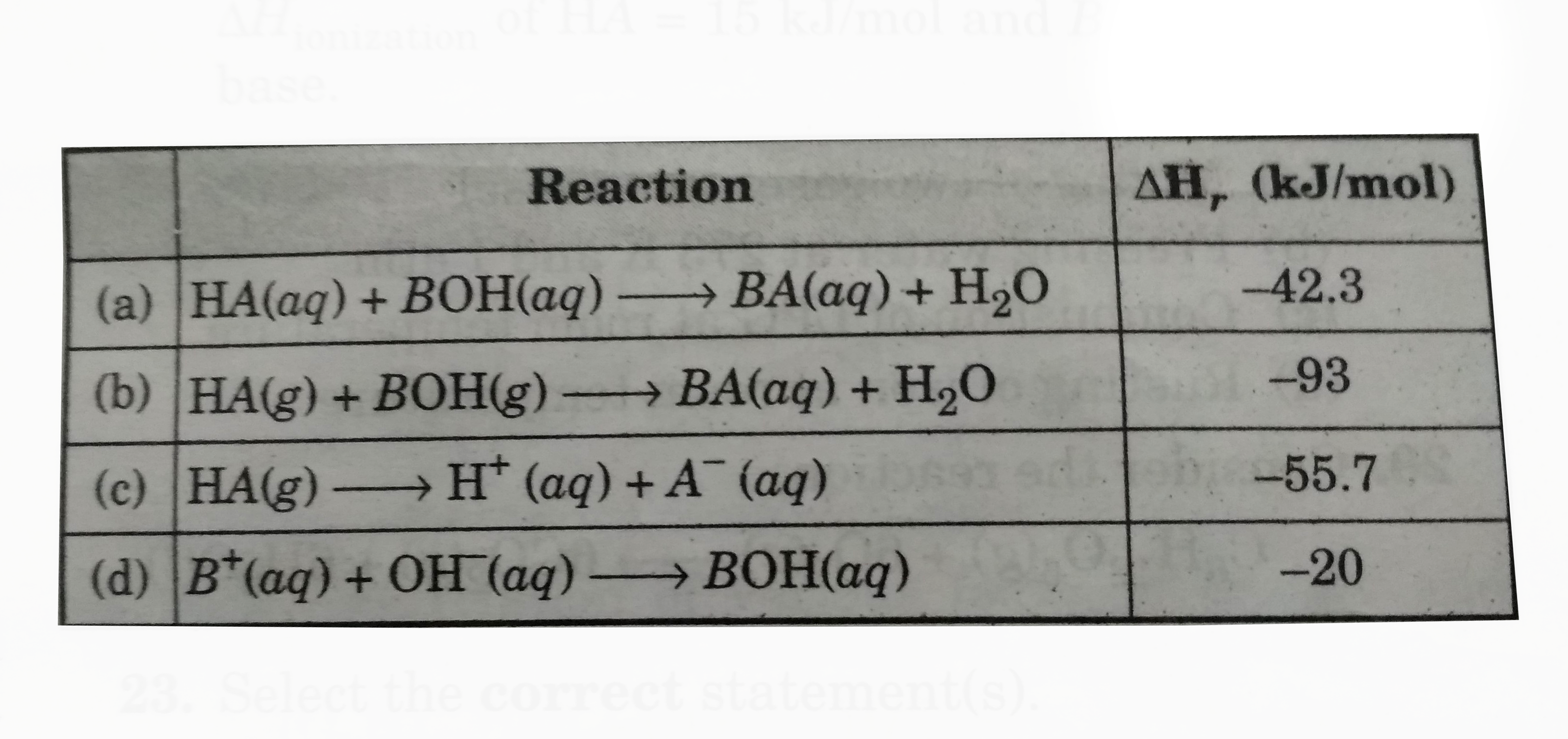From the following data, mark the option (s) where ΔH is correctlt written for the given reaction. Given
H+(aq)+OH−(aq)→H2O(l),ΔH=−57.3kJ
ΔHsolution of HA(g) = -70.7kJ/mol
ΔHsolution of BOH(g) = 20kJ/mol
ΔHionization of HA = 15 kJ/mol and BOH is a strong base Reaction ΔHr(kJ/mol)
HA(aq)+BOH(aq)→BA(aq)+H2O−42.3
HA(g)+BOH(g)→BA(aq)+H2O−93.0
HA(g)→H+(aq)+A−(aq)−55.7
B+(aq)+OH−(aq)→BOH(aq)−20.0
The correct Answer is:A, B, C
(a) −57.3−(−15) , (b) −70.7+20+15−57.3
(c) −70.7+15
Topper's Solved these Questions
- THERMODYNAMICSBook:NARAYNAChapter:THERMODYNAMICSExercise:Level-VI
Explore 150 Videos
- THERMODYNAMICSBook:NARAYNAChapter:THERMODYNAMICSExercise:Passages
Explore 13 Videos
- THERMODYNAMICSBook:NARAYNAChapter:THERMODYNAMICSExercise:Level-II (H.W)
Explore 24 Videos
- STRUCTURE OF ATOMBook:NARAYNAChapter:STRUCTURE OF ATOMExercise:EXERCISE - IV EXEMPLAR PROBLEMS
Explore 24 Videos
Similar Questions
From the following date , mark the opation(s) where ΔH is correctly written for the given reaction .
Given: H+(aq)+OH−(aq)→H2O(l),
ΔH=−57.3kJ
ΔHsolutionHA(g)=−70.7kJmole
ΔHsolutionBOH(g)=−20kJmole
ΔHionzatoin of HA=15kJ/mole and BOH is a strong base.

View SolutionWhenever an acid is neutralized by a base, the net reaction is
H⊕(aq)+¯¯¯OH(aq)→H2O(l)(l),ΔH=−57.1kJ.
Calculate the heat evolved for the following experiment?
0.50 mol of solution is mixed with 0.30 mol of KOH solution.
View Solution
Knowledge Check
From the following data, mark the option (s) where ΔH is correctly written for the given reaction. Given:
H+(aq)+OH−(aq)→H2O(l) ΔH=−57.3kJ
ΔHsolution of HA(g)=−70.7 kJ/mol
Δsolution of BOH(g)=20 kJ/mol
ΔHionization of HA=15 kJ/mol & BOH is a strong baseAReactionΔHR (kJ/mole)HA(aq)+BOH(aq)→BA(aq)+H2O−42.3BReactionΔHR (kJ/mole)HA(g)+BOH(g)→BA(aq)+H2O−93CReactionΔHR (kJ/mole)HA(g)→H+(aq)+A−(aq)−55.7DReactionΔHR (kJ/mole)B+(aq)+OH−(aq)→BOH(aq)−20For the reaction
PCI3(g)+CI2(g)→PCI5(g),ΔH=−xkJ
If the ΔH∘fPCI3is−ykJ, what is ΔH∘fPCI5 ?A(x−y)kJB(y−x)kJC−(x+y)kJD(x+y)kJWhat is the enthalpy of neutralization of HF against a strong base?
Given : H+(aq)+OH−(aq)→H2O(l),ΔrH∘=−56kJ/mol
ΔsH∘(HF,aq)=−329kJ/mol,ΔsH∘(H2O,l)=−285kJ/mol
ΔsH∘(F−,aq)=−320 kJ/molA−17 kJ/molB−38 kJ/molC−47 kJ/molD−43 kJ/mol
Whenever an acid is neutralized by a base, the net reaction is
H⊕(aq)+¯¯¯OH(aq)→H2O(l),ΔH=−57.1kJ.
Calculate the heat evolved for the following experiment?
0.50 mol of HCl solution is neutralized by 0.50 mol of NaOH solution.
View SolutionFor the reaction : C2H5OH(l)+3O2(g)→2CO2(g)+3H2O(g)
if ΔU∘=−1373kJmol−1 at 298K. Calculate ΔH∘
View SolutionThe standard enthalpy of formation of ammonia gas is
Given: N2H4(g)+H2(g)→2NH3(g),ΔH∘r=−40kJ/mol
ΔH∘f[N2H4(g)]=−120kJ/mol
View SolutionIt is given :
H2O(s)→H2O(l),ΔH=6.05KJ
H2O(l)→H2O(g),ΔH=43.7KJ
The heat of sublimation of ice is 273 K is
View SolutionCalculate P−Cl bond enthalpy
Given :ΔrH(PCl3,g)=306kJ/mol
ΔHat omization(P,s)=314kJ/mol,
ΔrH(Cl,g)=121kJ/mol
View Solution